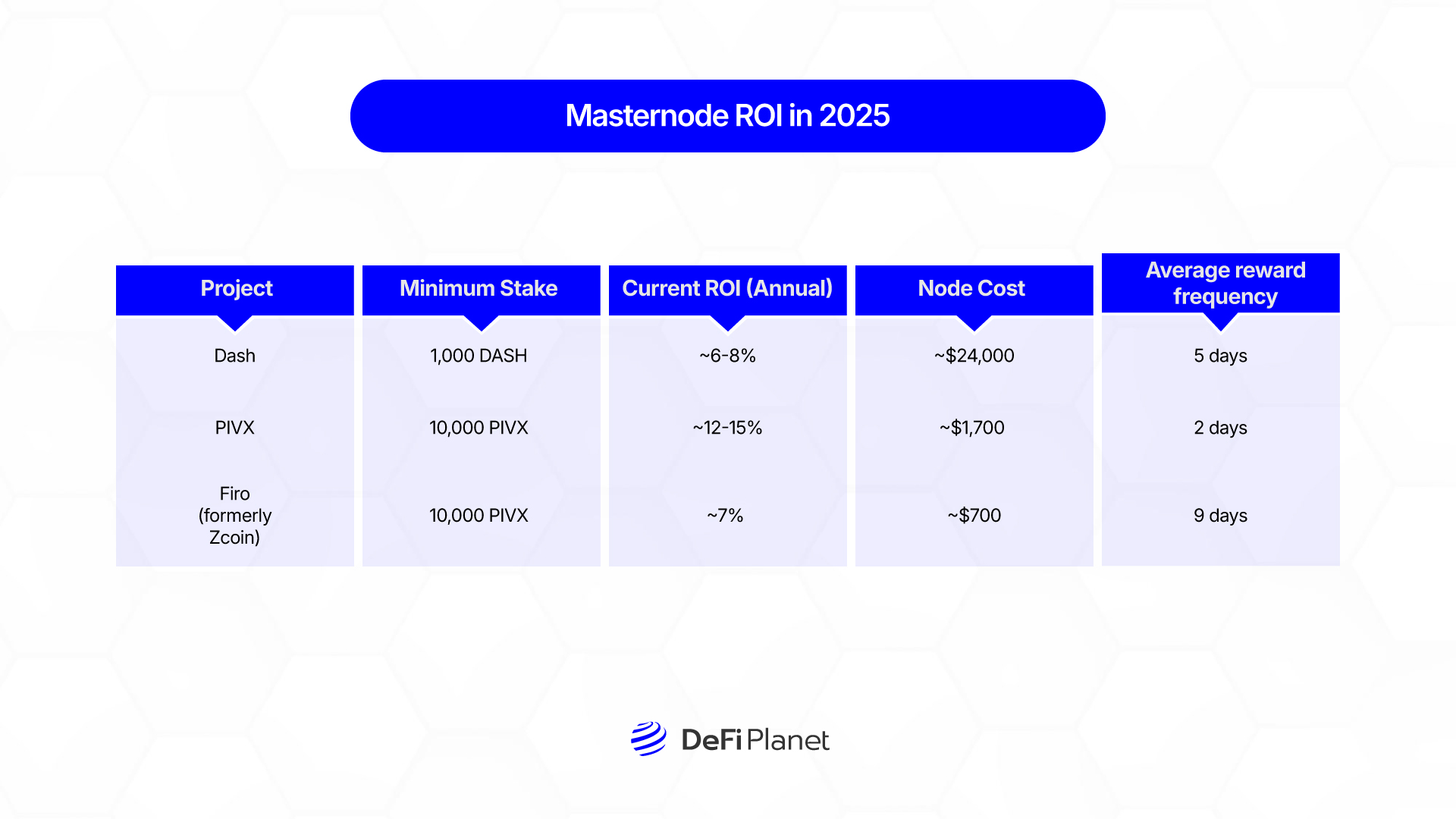In the late 2010s and early 2020s, masternodes emerged as a popular way for cryptocurrency enthusiasts to earn passive income. By operating a masternode, users could lock up a certain amount of a project’s native tokens and receive rewards for helping validate transactions and secure blockchain networks. Projects like Dash and PIVX pioneered this model, offering holders a way to earn steady returns without active trading.
Back then, masternodes were often seen as a relatively low-effort, high-reward investment — a crypto “rental income” of sorts. But as the crypto landscape evolved, so did the challenges facing masternode operators. Increasing competition, shifting reward mechanisms, and new regulatory scrutiny have led many to ask: Are masternodes still profitable in 2025, or has the opportunity passed?
In this article, we’ll explore how masternodes work, the current market realities, risks involved, and whether they remain a smart passive income option today.
What are masternodes?
Masternodes are specialized servers/nodes within a blockchain network that perform functions beyond those of regular full nodes. While regular nodes simply validate and relay transactions, masternodes handle additional tasks such as enabling instant or private transactions, managing governance voting, and improving network stability.
For example, Dash’s masternodes power its InstantSend feature, which allows near-instant transactions, and CoinJoin, which enhances privacy by mixing coins to obfuscate transaction trails. These extra services help differentiate masternode-based blockchains from others.
To run a masternode, users must lock up a specific amount of the network’s native cryptocurrency as collateral. This stake ensures they have a vested interest in acting honestly and supporting the network. In return, masternode operators receive block rewards or transaction fees proportional to their contribution.
How do they work?
There are two main masternode requirements. First, you must own a specific amount of cryptocurrency to use as “collateral.” This collateral is then locked to the network in a process called staking, and it is seen as a significant investment designed to ensure network security and stability.
The masternode staking requirements differ from network to network. To give you an example, a Dash masternode needs 1,000 DASH. which as of current prices (May 2025), that’s about $24000. Other projects vary from a few thousand dollars to tens of thousands, depending on the token price and network rules.
Secondly, you need enough processing power and storage capacity in your hardware. A reliable server with specifications such as a dual-core 2 GHz CPU, 4 to 8 GB RAM, and sufficient storage (60–80 GB) is needed to run the node 24/7. Operators also require basic system administration skills to set up, secure, and maintain the masternode.
Once your masternode is running, you’ll be eligible for rewards — aka passive income. Payouts vary depending on the project. On the Dash network, masternode payments are randomly selected for each block (every 2.6 minutes). It’s not possible to predict when exactly your payment will occur. But on Evonode, masternodes are paid at the end of each “epoch,” roughly every 10 days.
Because of these requirements, masternodes tend to attract technically savvy investors or those willing to pay third-party hosting services, which add to operating costs.
How much ROI can you expect from running masternodes?
In the late 2010s, masternodes were lucrative. For instance, LuxCoin masternodes in 2018 offered annualized returns above 60%, with nodes valued over $30,000 each. The limited competition and high network rewards meant operators earned strong passive income relative to their locked collateral. Many investors saw masternodes as a “set-and-forget” income source with the potential for capital gains if token prices rose.
Dash masternodes during peak years also boasted 7-10% annual ROI paid in DASH tokens, with the added benefit of network utility features.
However, as masternodes gained popularity, the number of active nodes increased significantly across various networks. This oversaturation led to smaller reward shares per node. Some networks have also reduced block rewards or increased token supply to control inflation, further compressing masternode ROI.
For example, Dash’s annual masternode ROI has dropped closer to 5-7% in recent years. When adjusted for DASH’s price fluctuations, the real-dollar returns can be volatile and sometimes negative during bear markets.

Adding to the challenge, the price of the collateral token itself can be highly volatile. Locking a large amount of crypto during a downturn ties up capital that may lose value, making it difficult to break even or profit.
Regulatory Scrutiny and Compliance Issues
Regulatory frameworks around crypto have tightened globally, affecting masternode operators as well. For example, in the U.S., the Internal Revenue Service (IRS) has implemented regulations that mandate detailed reporting on crypto transactions through forms like 1099-DIV, increasing tax compliance burdens. Also, South Korea plans to regulate cross-border virtual asset transactions starting in late 2025. This will add legal complexities for masternode operators dealing internationally.
These regulatory developments add operational risk and may increase costs associated with running masternodes, especially for smaller or individual operators.
Masternodes vs. newer crypto passive income strategies
Masternodes no longer hold a monopoly on crypto passive income. There are newer and flexible staking models which require smaller minimum stakes and less technical effort.
Proof-of-Stake (PoS) Staking
Many major blockchains like Ethereum (after the Merge), Solana, and Cardano allow token holders to stake coins directly to validate transactions and earn rewards without running a full masternode server. Staking often requires less technical skill and lower minimum deposits, attracting a broader audience.
DeFi Yield Farming and Restaking
Decentralized finance (DeFi) platforms offer a range of yield opportunities. Protocols like Aave, Compound, and Uniswap enable liquidity provision and lending that yield competitive returns.
Restaking protocols such as EigenLayer allow users to “relock” their staked ETH to earn additional rewards, multiplying passive income without extra hardware or complex setups.
READ MORE: Yield-Bearing Assets in DeFi: How Do They Work and How Can You Maximize Them
Flexible Liquid Staking Derivatives
Innovations in liquid staking allow users to keep their staked tokens liquid and tradable, reducing the risk of locked capital and enhancing exit flexibility—something traditional masternodes lack.
The lower technical barriers, higher liquidity, and often more attractive returns have led many investors to prefer these models over masternodes.
READ MORE: Simple Ways To Earn Passive Income From Your Crypto
Key considerations before deciding to run a masternode operation
If you’re considering running a masternode today, here are some factors to evaluate.
1. Reward sustainability
Many masternode networks have reduced rewards to manage inflation. Operators must analyze the current block reward, tokenomics, and inflation rates to assess long-term viability. An ROI of 5-7% may be decent in crypto terms, but could lag behind other passive income strategies.
2. Liquidity and exit strategy
Locking large amounts of crypto creates liquidity risk. Before investing, check the token’s market liquidity and trading volume. Illiquid tokens can be difficult to sell without slippage, exposing operators to losses during market downturns.
3. Technical and operational risks
Running a masternode demands constant maintenance, server uptime, and security vigilance. Downtime can result in missed rewards or penalties. If you lack the technical skills, consider professional hosting, but factor in service fees.
4. Network fundamentals and use case
Evaluate the masternode’s underlying network. Does the project still rely heavily on masternodes for core functions like governance or privacy? Some blockchains are transitioning toward pure PoS models or Layer 2 solutions, potentially making masternodes obsolete.
5. Institutional influence and competition
Large institutional players running masternodes at scale can crowd out smaller operators and drive down profitability. Additionally, some networks favour stakers over masternode operators in upcoming upgrades.
Is running a masternode still worth it in 2025?
Rather than viewing masternodes as a guaranteed passive income source, see them as one tool among many in crypto investing. They offer potential rewards tied directly to network utility and decentralization, but come with technical, financial, and regulatory hurdles.
If you’re considering masternodes as part of your crypto strategy, before committing capital, here are the steps to take
- Research the network’s masternode requirements and reward structure
- Calculate the realistic ROI after factoring in collateral price, fees, and maintenance
- Understand your risk tolerance for locked assets and regulatory changes
- Compare alternatives in staking and DeFi that might better fit your goals
By approaching masternodes with a clear-eyed view of their benefits and limitations, investors can decide whether this model suits their portfolio or has become a relic of crypto’s earlier days.
In summary, running masternodes in 2025 is neither a universal win nor a dead-end. It remains a niche, technical, and potentially rewarding path — but one that demands careful consideration amid an ever-shifting crypto landscape.
Disclaimer: This article is intended solely for informational purposes and should not be considered trading or investment advice. Nothing herein should be construed as financial, legal, or tax advice. Trading or investing in cryptocurrencies carries a considerable risk of financial loss. Always conduct due diligence.
If you would like to read more articles like this, visit DeFi Planet and follow us on Twitter, LinkedIn, Facebook, Instagram, and CoinMarketCap Community.
Take control of your crypto portfolio with MARKETS PRO, DeFi Planet’s suite of analytics tools.”

